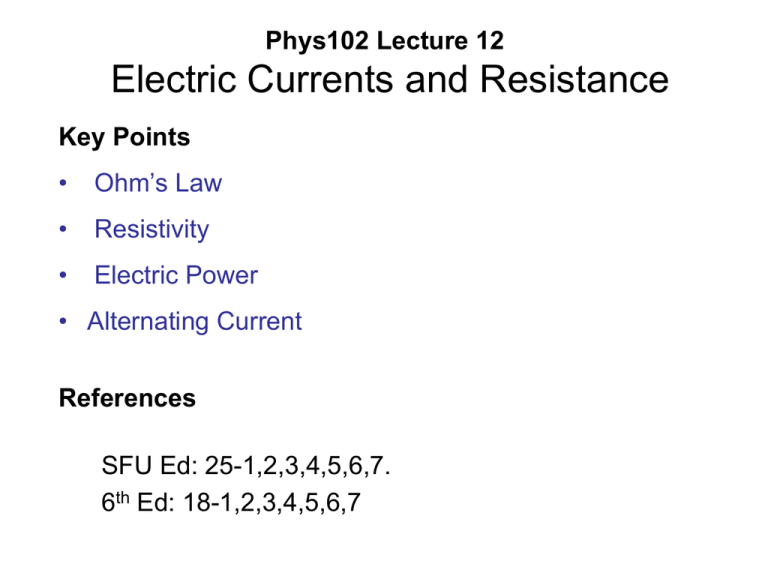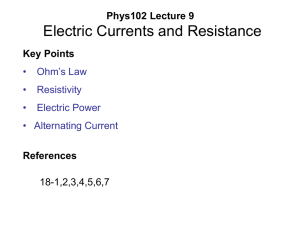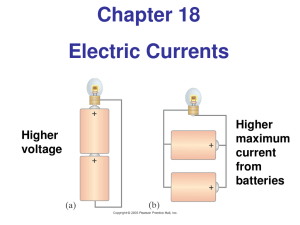Electric Currents and Resistance
advertisement

Phys102 Lecture 12 Electric Currents and Resistance Key Points • Ohm’s Law • Resistivity • Electric Power • Alternating Current References SFU Ed: 25-1,2,3,4,5,6,7. 6th Ed: 18-1,2,3,4,5,6,7 25-1 The Electric Battery Volta discovered that electricity could be created if dissimilar metals were connected by a conductive solution called an electrolyte. This is a simple electric cell. 25-1 The Electric Battery A battery transforms chemical energy into electrical energy. Chemical reactions within the cell create a potential difference between the terminals by slowly dissolving them. This potential difference can be maintained even if a current is kept flowing, until one or the other terminal is completely dissolved. 25-2 Electric Current Electric current is the rate of flow of charge through a conductor: The instantaneous current is given by: Unit of electric current: the ampere, A: 1 A = 1 C/s. 25-2 Electric Current A complete circuit is one where current can flow all the way around. Note that the schematic drawing doesn’t look much like the physical circuit! 25-2 Electric Current By convention, current is defined as flowing from + to -. Electrons actually flow in the opposite direction, but not all currents consist of electrons. 25-3 Ohm’s Law: Resistance and Resistors Experimentally, it is found that the current in a wire is proportional to the potential difference between its ends: 25-3 Ohm’s Law: Resistance and Resistors The ratio of voltage to current is called the resistance: 25-3 Ohm’s Law: Resistance and Resistors Example 25-4: Flashlight bulb resistance. A small flashlight bulb draws 300 mA from its 1.5-V battery. (a) What is the resistance of the bulb? (b) If the battery becomes weak and the voltage drops to 1.2 V, how would the current change? 25-4 Resistivity The resistance of a wire is directly proportional to its length and inversely proportional to its cross-sectional area: The constant ρ, the resistivity, is characteristic of the material. 25-4 Resistivity This table gives the resistivity and temperature coefficients of typical conductors, semiconductors, and insulators. 25-4 Resistivity Conceptual Example 25-6: Stretching changes resistance. Suppose a wire of resistance R could be stretched uniformly until it was twice its original length. What would happen to its resistance? 25-5 Electric Power Power, as in kinematics, is the energy transformed by a device per unit time: or 25-5 Electric Power The unit of power is the watt, W. For ohmic devices, we can make the substitutions: 25-5 Electric Power Example 25-8: Headlights. Calculate the resistance of a 40-W automobile headlight designed for 12 V. 25-5 Electric Power What you pay for on your electric bill is not power, but energy – the power consumption multiplied by the time. We have been measuring energy in joules, but the electric company measures it in kilowatt-hours, kWh: 1 kWh = (1000 W)(3600 s) = 3.60 x 106 J. 25-5 Electric Power Example 25-9: Electric heater. An electric heater draws a steady 15.0 A on a 120-V line. How much power does it require and how much does it cost per month (30 days) if it operates 3.0 h per day and the electric company charges 9.2 cents per kWh? 25-6 Power in Household Circuits Conceptual Example 25-12: A dangerous extension cord. Your 1800-W portable electric heater is too far from your desk to warm your feet. Its cord is too short, so you plug it into an extension cord rated at 11 A. Why is this dangerous? 25-7 Alternating Current Current from a battery flows steadily in one direction (direct current, DC). Current from a power plant varies sinusoidally (alternating current, AC). 25-7 Alternating Current The voltage varies sinusoidally with time: ,, as does the current: 25-7 Alternating Current Multiplying the current and the voltage gives the power: 25-7 Alternating Current Usually we are interested in the average power: . 25-7 Alternating Current The current and voltage both have average values of zero, so we square them, take the average, then take the square root, yielding the root-mean-square (rms) value: 25-7 Alternating Current Example 25-13: Hair dryer. (a) Calculate the resistance and the peak current in a 1000-W hair dryer connected to a 120-V line. (b) What happens if it is connected to a 240-V line in Britain? Summary of Chapter 25 • A battery is a source of constant potential difference. • Electric current is the rate of flow of electric charge. • Conventional current is in the direction that positive charge would flow. • Resistance is the ratio of voltage to current: Summary of Chapter 25 • Ohmic materials have constant resistance, independent of voltage. • Resistance is determined by shape and material: • ρ is the resistivity. Summary of Chapter 25 • Power in an electric circuit: • Direct current is constant. • Alternating current varies sinusoidally: Summary of Chapter 25 • The average (rms) current and voltage:







